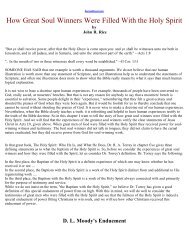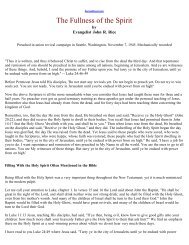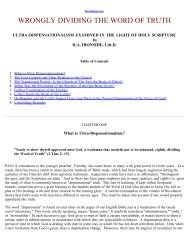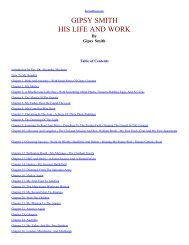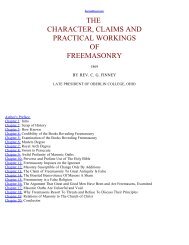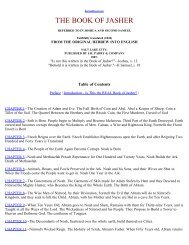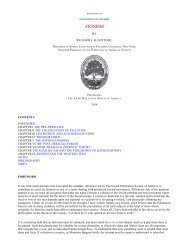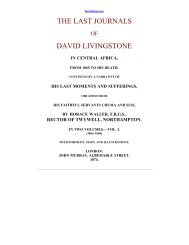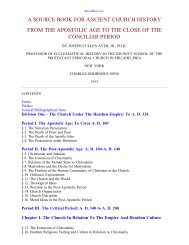Legends of Babylon and Egypt in Relation to Hebrew Tradition.pdf
Legends of Babylon and Egypt in Relation to Hebrew Tradition.pdf
Legends of Babylon and Egypt in Relation to Hebrew Tradition.pdf
Create successful ePaper yourself
Turn your PDF publications into a flip-book with our unique Google optimized e-Paper software.
[3] Ezek. i. 1, 3; iii. 23; <strong>and</strong> cf. x. 15, 20, 22, <strong>and</strong> xliii. 3.<br />
[4] See J. A. Montgomery, /Aramaic Incantation Texts from Nippur/, 1913<br />
[5] Hilprecht, /Explorations/, p. 555 f.<br />
Of the many thous<strong>and</strong>s <strong>of</strong> <strong>in</strong>scribed clay tablets which were found <strong>in</strong> the course <strong>of</strong> the expeditions, some were kept at<br />
Constant<strong>in</strong>ople, while others were presented by the Sultan Abdul Hamid <strong>to</strong> the excava<strong>to</strong>rs, who had them conveyed <strong>to</strong><br />
America. S<strong>in</strong>ce that time a large number have been published. The work was necessarily slow, for many <strong>of</strong> the texts<br />
were found <strong>to</strong> be <strong>in</strong> an extremely bad state <strong>of</strong> preservation. So it happened that a great number <strong>of</strong> the boxes conta<strong>in</strong><strong>in</strong>g<br />
tablets rema<strong>in</strong>ed until recently still packed up <strong>in</strong> the s<strong>to</strong>re-rooms <strong>of</strong> the Pennsylvania Museum. But under the present<br />
energetic Direc<strong>to</strong>r <strong>of</strong> the Museum, Dr. G. B. Gordon, the process <strong>of</strong> arrang<strong>in</strong>g <strong>and</strong> publish<strong>in</strong>g the mass <strong>of</strong> literary<br />
material has been "speeded up". A staff <strong>of</strong> skilled workmen has been employed on the laborious task <strong>of</strong> clean<strong>in</strong>g the<br />
broken tablets <strong>and</strong> fitt<strong>in</strong>g the fragments <strong>to</strong>gether. At the same time the help <strong>of</strong> several Assyriologists was welcomed <strong>in</strong><br />
the further task <strong>of</strong> runn<strong>in</strong>g over <strong>and</strong> sort<strong>in</strong>g the collections as they were prepared for study. Pr<strong>of</strong>essor Clay, Pr<strong>of</strong>essor<br />
Bar<strong>to</strong>n, Dr. Langdon, Dr. Edward Chiera, <strong>and</strong> Dr. Arno Poebel have all participated <strong>in</strong> the work. But the lion's share<br />
has fallen <strong>to</strong> the last-named scholar, who was given leave <strong>of</strong> absence by John Hopk<strong>in</strong>s University <strong>in</strong> order <strong>to</strong> take up a<br />
temporary appo<strong>in</strong>tment at the Pennsylvania Museum. The result <strong>of</strong> his labours was published by the Museum at the<br />
end <strong>of</strong> 1914.[1] The texts thus made available for study are <strong>of</strong> very varied <strong>in</strong>terest. A great body <strong>of</strong> them are<br />
grammatical <strong>and</strong> represent compilations made by Semitic scribes <strong>of</strong> the period <strong>of</strong> Hammurabi's dynasty for their study<br />
<strong>of</strong> the old Sumerian <strong>to</strong>ngue. Conta<strong>in</strong><strong>in</strong>g, as most <strong>of</strong> them do, Semitic render<strong>in</strong>gs <strong>of</strong> the Sumerian words <strong>and</strong><br />
expressions collected, they are as great a help <strong>to</strong> us <strong>in</strong> our study <strong>of</strong> Sumerian language as they were <strong>to</strong> their compilers;<br />
<strong>in</strong> particular they have thrown much new light on the paradigms <strong>of</strong> the demonstrative <strong>and</strong> personal pronouns <strong>and</strong> on<br />
Sumerian verbal forms. But literary texts are also <strong>in</strong>cluded <strong>in</strong> the recent publications.<br />
[1] Poebel, /His<strong>to</strong>rical Texts/ <strong>and</strong> /His<strong>to</strong>rical <strong>and</strong> Grammatical Texts/ (Univ. <strong>of</strong> Penns. Mus. Publ., Bab. Sect., Vol. IV,<br />
No. 1, <strong>and</strong> Vol. V), Philadelphia, 1914.<br />
When the Pennsylvania Museum sent out its first expedition, lively hopes were enterta<strong>in</strong>ed that the site selected would<br />
yield material <strong>of</strong> <strong>in</strong>terest from the biblical st<strong>and</strong>po<strong>in</strong>t. The city <strong>of</strong> Nippur, as we have seen, was one <strong>of</strong> the most sacred<br />
<strong>and</strong> most ancient religious centres <strong>in</strong> the country, <strong>and</strong> Enlil, its city-god, was the head <strong>of</strong> the <strong>Babylon</strong>ian pantheon. On<br />
such a site it seemed likely that we might f<strong>in</strong>d versions <strong>of</strong> the <strong>Babylon</strong>ian legends which were current at the dawn <strong>of</strong><br />
his<strong>to</strong>ry before the city <strong>of</strong> <strong>Babylon</strong>ia <strong>and</strong> its Semitic <strong>in</strong>habitants came upon the scene. This expectation has proved <strong>to</strong> be<br />
not unfounded, for the literary texts <strong>in</strong>clude the Sumerian Deluge Version <strong>and</strong> Creation myth <strong>to</strong> which I referred at the<br />
beg<strong>in</strong>n<strong>in</strong>g <strong>of</strong> the lecture. Other texts <strong>of</strong> almost equal <strong>in</strong>terest consist <strong>of</strong> early though fragmentary lists <strong>of</strong> his<strong>to</strong>rical <strong>and</strong><br />
semi-mythical rulers. They prove that Berossus <strong>and</strong> the later <strong>Babylon</strong>ians depended on material <strong>of</strong> quite early orig<strong>in</strong> <strong>in</strong><br />
compil<strong>in</strong>g their dynasties <strong>of</strong> semi-mythical k<strong>in</strong>gs. In them we obta<strong>in</strong> a glimpse <strong>of</strong> ages more remote than any on which<br />
excavation <strong>in</strong> <strong>Babylon</strong>ia has yet thrown light, <strong>and</strong> for the first time we have recovered genu<strong>in</strong>e native tradition <strong>of</strong> early<br />
date with regard <strong>to</strong> the cradle <strong>of</strong> <strong>Babylon</strong>ian culture. Before we approach the Sumerian legends themselves, it will be<br />
as well <strong>to</strong>-day <strong>to</strong> trace back <strong>in</strong> this tradition the gradual merg<strong>in</strong>g <strong>of</strong> his<strong>to</strong>ry <strong>in</strong><strong>to</strong> legend <strong>and</strong> myth, compar<strong>in</strong>g at the<br />
same time the ancient <strong>Egypt</strong>ian's picture <strong>of</strong> his own remote past. We will also ascerta<strong>in</strong> whether any new light is<br />
thrown by our <strong>in</strong>quiry upon <strong>Hebrew</strong> traditions concern<strong>in</strong>g the earliest his<strong>to</strong>ry <strong>of</strong> the human race <strong>and</strong> the orig<strong>in</strong>s <strong>of</strong><br />
civilization.<br />
In the study <strong>of</strong> both <strong>Egypt</strong>ian <strong>and</strong> <strong>Babylon</strong>ian chronology there has been a tendency <strong>of</strong> late years <strong>to</strong> reduce the very<br />
early dates that were formerly <strong>in</strong> fashion. But <strong>in</strong> <strong>Egypt</strong>, while the dynasties <strong>of</strong> Manetho have been telescoped <strong>in</strong> places,<br />
excavation has thrown light on predynastic periods, <strong>and</strong> we can now trace the his<strong>to</strong>ry <strong>of</strong> culture <strong>in</strong> the Nile Valley<br />
back, through an unbroken sequence, <strong>to</strong> its neolithic stage. Quite recently, <strong>to</strong>o, as I mentioned just now, a fresh literary<br />
record <strong>of</strong> these early predynastic periods has been recovered, on a fragment <strong>of</strong> the famous Palermo Stele, our most<br />
valuable monument for early <strong>Egypt</strong>ian his<strong>to</strong>ry <strong>and</strong> chronology. <strong>Egypt</strong> presents a strik<strong>in</strong>g contrast <strong>to</strong> <strong>Babylon</strong>ia <strong>in</strong> the<br />
comparatively small number <strong>of</strong> written records which have survived for the reconstruction <strong>of</strong> her his<strong>to</strong>ry. We might<br />
well spare much <strong>of</strong> her religious literature, enshr<strong>in</strong>ed <strong>in</strong> endless temple- <strong>in</strong>scriptions <strong>and</strong> papyri, if we could but<br />
exchange it for some <strong>of</strong> the royal annals <strong>of</strong> <strong>Egypt</strong>ian Pharaohs. That his<strong>to</strong>rical records <strong>of</strong> this character were compiled<br />
by the <strong>Egypt</strong>ian scribes, <strong>and</strong> that they were as detailed <strong>and</strong> precise <strong>in</strong> their <strong>in</strong>formation as those we have recovered



